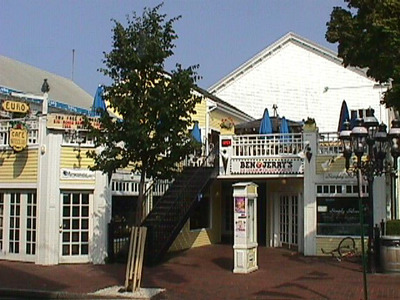258 Commercial St
Historic District Survey information for 258 Commercial St | |
Architectural Description: 258 Commercial St. is a 3-story, 3-4 bay, Greek Revival-style meetinghouse that has been converted to commercial use; gable-front roof is sheathed in asphalt shingles, partial cornice returns; exterior of historic core is clad in wood shingles, clapboard siding on modern commercial addition, wood corner pilasters, modillions and trim; foundation is obscured; 1-story irregularly-shaped modern commercial building extends from front facade; addition has central recessed area, roof deck, small central section with hipped roof, and 2nd-story section in rear corner; fenestration includes 2/2 DHS on core and fixed windows with transoms on addition; addition is accessed by multi-pane doors in multiple entries; storefront does not exhibit Greek Revival style. |
|
Historical Narrative: As per Josephine Del Deo (1977): "The first church building in Provincetown was erected, probably around 1717, on "Meeting House Plain" across Winthrop Street from and south of the Old Cemetery. Shank Painter Pond, now much reduced in size, came close to the structure. Some years later a second and larger church was build on or near the same site and this in turn gave way to the famous "Old White Oak" which was dedicated on February 20, 1774. The latter edifice, framed from the timber which gave it its name, stood about where the Catholic rectory now is.
The church society that built and occupied these meeting houses was "orthodox", bringing the Calvinistic doctrine of the Pilgrims down through the years unchallenged, for almost two centuries, in the Cape communities. With the arrival of Methodism came schism and in 1830 the "Old White Oak" closed its doors and the parish it had served went out of active existence. In 1843 it was torn down and new edifice, for a new society, was framed from the old timbers. This structure is still sanding, is the "Congregations Church of the Pilgrims" on Commercial Street west of Town Hall.
It was also common practice in the early days of the community to select all the officers for the town affairs from the membership of the Congregational parish. These men were almost automatically the deacons of the church as well as the officers of the town, This tradition must have been broken at some point after Methodism began, but for a long period the tradition remained. It is thought that early records of the town which have seemingly been irretrievable lost may have been stored or kept in the Congregational Church instead of Town Hall. This is little hope of their recover however at this date." |
|
Bibliography and/or References: Hatch, Mellen, C.M. :The Log of Provincetownand Turro, pp 29, 30.
Comments of Geroge Bryant, Grand Bank Archives, Provincetown. |
|
Text |
|
Commercial Street (Provincetown, Mass.), Dwellings, and Historic Districts--Massachusetts--Provincetown |
|
Comments (0)
NOTICE: It appears you do not have Javascript enabled in your Web browser. To access some of the features on the site (including email links) you must enable Javascript and refresh the page.



There are no comments for this archive.